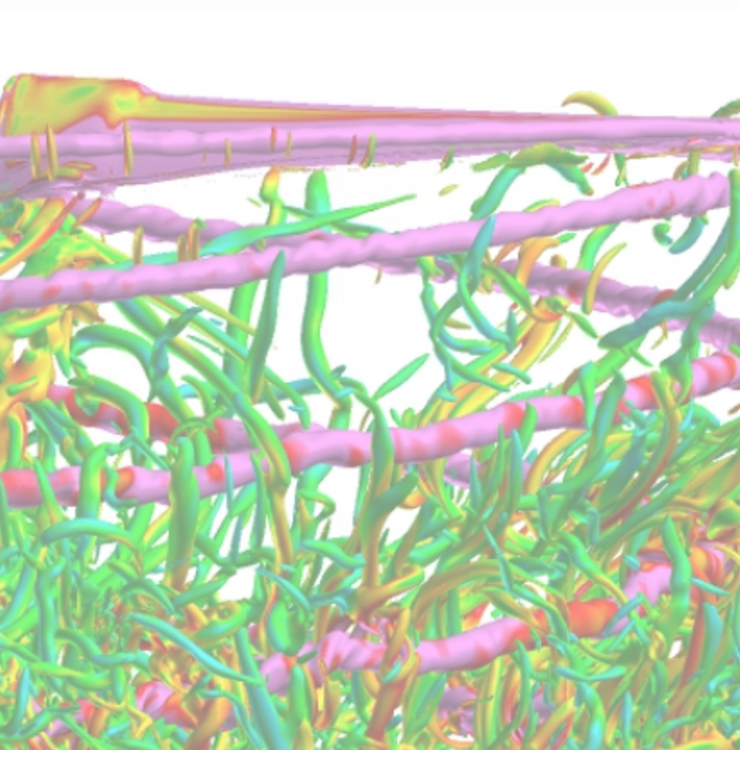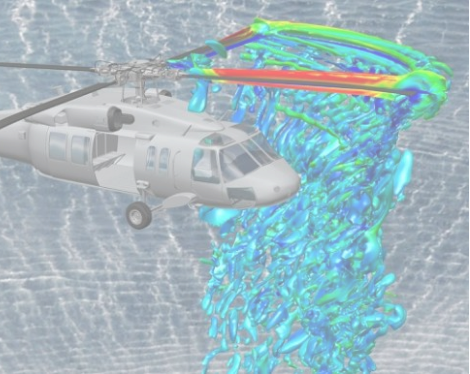


By:
Kombyne™ is a new in-situ visualization and analysis tool for HPC simulations.
With Scientific Computing solutions specifically tuned for HPC, innovations and discoveries will follow.
Kombyne™ is an innovative new SaaS High Performance Computing (HPC)workflow tool, initially developed for customers in the defense, automotive, aerospace industries and academic research. It allows users to subscribe to a range of workflow solutions for HPC CFD jobs, from on-the-fly extract generation and rendering to simulation steering. Interactive monitoring and control is also available, all with minimal simulation disruption and no reliance on VTK. The need for large files is eliminated via extract workflows and real-time visualization.
An in transit workflow uses a separate process that quickly receives data from the solver code and performs visualization and analysis without interfering with the running solver. This process, called an Endpoint, can directly output extracts such as iso surfaces, cutting planes or point samples for data science and can render images as well. The Endpoint can also act as a bridge to popular visualization codes such as FieldView, VisIt and ParaView, enabling interactive visualization without stopping the solver code. Kombyne™ is the first commercially supported product that provides full in situ and in transit post-processing, rendering and data science sampling.
An in transit workflow uses a separate process that quickly receives data from the solver code and performs visualization and analysis without interfering with the running solver. This process, called an Endpoint, can directly output extracts such as iso surfaces, cutting planes or point samples for data science and can render images as well. The Endpoint can also act as a bridge to popular visualization codes such as FieldView, VisIt and ParaView, enabling interactive visualization without stopping the solver code. Kombyne™ is the first commercially supported product that provides full in situ and in transit post-processing, rendering and data science sampling.

In situ, which means in place, is a technology which permits simulation results to be obtained directly from the memory of the scientific computing application executing at a HPC, avoiding the need to write tend to very large result files. If provided adaptor added to the HPC application, during execution the needed information can be extracted to check progress and convergence of the solution, produce data to create graphics to probe solutions, etc.
Why it Matters?
As seen from the figure below, application throughput factor of change with in situ increases tremendously. Analyst now have control over their "scientific applications costly time-spent" on HPC platforms.
What is In-Situ?
In transit, refers to a set of libraries has hitherto also contained “transports” which can send data in transit to an analysis program called the Kombyne™ “Endpoint”. Transports exist for MPI, ZeroMQ, and ADIOS2 for HPC applications. Kombyne™ consists of an in situ library that can perform limited computations inside of the simulation, mostly sending data of interest to an analysis endpoint program that runs on additional compute nodes. This essentially splits the in situ work into two parts, a simple, efficient and easy method to integrate ‘collector’, and an endpoint process that runs on a separate set of hardware resources (nodes, memory and accelerators.)
What is In-Transit?

Versions of Kombyne™
Kombyne™ comes in two flavors: Kombyne™ and Kombyne™ Lite. Kombyne™-Lite including in-Situ tools will be the free version. In-Situ tools and In transit tools, in addition to, an interactive GUI can be licensed through subscriptions.
Kombyne™ is available for the following applications
OVERFLOW from NASA
Installation is extremely easy for Kombyne™ using prebuilt modules for OVERFLOW2, Hydra, PyFR, OpenFOAM, and more every day. For other solvers or inhouse solvers, a small adapter library is used to link Kombyne™ into the solver. Kombyne™ provides native APIs in FORTRAN, C/C++ and Python and is scalable via MPI. In batch operation, a simple parameter datafile sets up the functions to be performed during simulation.
KombyneTM
HYDRA-CFD from Rolls Royce
PyFR open source CFD solver
OpenFOAM open source CFD solver
KombyneTM
OVERFLOW from NASA
HYDRA-CFD from Rolls Royce
PyFR open source CFD solver
OpenFOAM open source CFD solver
Kombyne™ Benefits
Ease of integration and support
#1
Experienced users have written the protocols necessary on your behalf.
#2
User interfaces to solver codes that includes monitoring and steering
Simple to use interface which allows for “If, Then..” coupling to solvers to “steer” the analysis.
#3
Performance portable, open architecture that supports heterogeneous hardware
We must take the majority of HPC hardware into consideration as potential engines for usage
in the mix of back-up computing… and we do.
in the mix of back-up computing… and we do.
#4
Integration and support from domain experts in CFD, Data Science, HPC and Visualization
These particular experience backgrounds exist and grow in our supporting engineers and scientist who are there to help you.
About Intelligent Light
Technology, Teamwork, Trust
Download Kombyne
Intelligent Light
301 Route 17N, 7th Floor,
Rutherford, NJ 07070
www.ilight.com
Email us for more info..
Copyright© 2021 – Privacy Policy
Intelligent Light
301 Route 17N, 7th Floor,
Rutherford, NJ 07070
www.ilight.com
Email us for more info..
Copyright© 2021 – Privacy Policy

Founded in 1984, Intelligent Light™ developed FieldView which became one of the world’s leading software tools for visualization and post-processing of CFD. In October 2019, Intelligent Light™ decided to spin-off FieldView into an entity focused on the packaged software business (FieldView CFD, Inc.) which now allows Intelligent Light™ to focus on subscription-based HPC and digital twin products. The company also participates in contracted R&D efforts.
Development of VisIt Prime™ and Kombyne™ was supported by the US Department of Energy via grants DE-SC0007548and DE-SC0018633, respectively.
Development of VisIt Prime™ and Kombyne™ was supported by the US Department of Energy via grants DE-SC0007548and DE-SC0018633, respectively.
Reduce risks and effectively manage resources for scientific computing
KombyneTM-Lite
KombyneTM
In-Situ Tools
In-Transit Tools
Interactive GUI
KombyneTM-Lite
KombyneTM
In-Situ Tools
In-Transit Tools
“Over the past decade, the convergence of accessible HPC and high-fidelity simulation has created a bottleneck in analysis workflows: writing, managing and reading very large files. Intelligent Light has provided in situ solutions via VisIt/Libsim used to access information directly from the memory of the running solver code. Based on our experience and customer input, we built Kombyne™ from the ground up to simplify the integration into solver codes and minimize the runtime impact on memory and performance via true ‘in transit’ operation.”
Steve M. Legensky
President and CTO
President and CTO
Who is using this technology?
Air Vehicle and Rotorcraft Design
- A joint project with NAVAIR in 2013
- Needed many seconds of 3D CFD
- Supported the Kestrel (CFD code) with VisIt libsim
- XDBs can by 21X smaller than volume files
Result: it is becoming a production tool for designers
- A joint project with NAVAIR in 2013
- Needed many seconds of 3D CFD
- Supported the Kestrel (CFD code) with VisIt libsim
- XDBs can by 21X smaller than volume files
Result: it is becoming a production tool for designers
DoD Program
In the framework of the PRESTIGE research project funded by the Federal Ministry of Economics and Technology our customer, which is a world-leading aero engine manufacturer, worked together with Intelligent Light to deploy the Kombyne and Scoreboard tools in order to increase the predictive capabilities of CFD with the goal of more accurately forecasting off-design engine performance. Those simulations are requiring unsteady calculations and meshes that are one to two orders of magnitude larger in size than current state-of-the-art models. Kombyne was therefore integrated into the customer’s CFD solver Hydra and provided two unique capabilities: ‘in transit’ operation to offload analysis tasks from the solver nodes, and ‘steering’ to enable runtime access to solver parameters. These tools help our customer to minimize interference with solver resources (memory and compute), greatly reducing the time and space needed for visualization and enabling control during computation and were successfully demonstrated on a high pressure compressor model with more than 5 Billion mesh nodes on the high-performance compute cluster of the TU Dresden.
Aeroengines
"We have been supporting a data science project, using modal and frequency analysis to characterize transonic ‘cylinder in crossflow’ physics, using NASA’s OVERFLOW2 solver, instrumented with Kombyne™ on the Department of Energy Cori supercomputer.This study required data at high frequency, essentially every solver time step. Using the standard I/O pipelines in OVERFLOW2 would have required excessive wall clock time. Kombyne™ was able to efficiently write the solution extracts to disk in various data formats that could be used by data analysis tools (Matlab) and visualization tools (VisIt, FieldView, Paraview).”
Dr. Earl P.N. Duque
VP of R&D
VP of R&D

